Item 1: Report to Shareholders
 |
| New Horizons Fund | June 30, 2007 |
The views and opinions in this report were current as of June 30, 2007. They are not guarantees of performance or investment results and should not be taken as investment advice. Investment decisions reflect a variety of factors, and the managers reserve the right to change their views about individual stocks, sectors, and the markets at any time. As a result, the views expressed should not be relied upon as a forecast of the fund’s future investment intent. The report is certified under the Sarbanes-Oxley Act, which requires mutual funds and other public companies to affirm that, to the best of their knowledge, the information in their financial reports is fairly and accurately stated in all material respects.
REPORTS ON THE WEB
Sign up for our E-mail Program, and you can begin to receive updated fund reports and prospectuses online rather than through the mail. Log in to your account at troweprice.com for more information.
Manager’s Letter
Fellow Shareholders
Stock markets in the U.S and around the world generated strong performance in the first half of 2007. Continued cyclical economic strength in the U.S and in most major non-U.S. economies, relatively benign inflation and interest rates, and a very favorable supply/demand environment for stocks due to record takeover activity and corporate share repurchases led to the healthy gains in stock prices. Equities overcame headwinds in the consumer sector, where weakness in the housing market and record-high oil prices restrained consumer spending somewhat. Investors also overlooked the continued bleak situation in Iraq and geopolitical turbulence in the Middle East and elsewhere.
Small-cap stocks, the focus of your fund’s investment program, performed roughly in line with large-caps in the first half. The small-cap Russell 2000 Index slightly underperformed the large-cap S&P 500 Index, but the average small-cap mutual fund outperformed the average large-cap fund in the six-month period. Since 1999, small-caps have consistently outperformed their larger counterparts but by a lesser margin in recent years. Over the last 12 months, small-caps trailed large-caps by a small margin. Small-cap growth stocks, the focus of your fund’s investment program, outperformed small-cap value stocks in the first half by almost five percentage points. We continue to believe that the small-cap growth segment is more attractive on a valuation basis than small-cap value stocks.
HIGHLIGHTS
• Stock markets were strong in the first six months of 2007, and small-caps performed roughly in line with large-caps.
• Thanks to takeovers and strong performance from our energy and telecommunication service holdings, the New Horizons Fund posted a solid return of 9.20% for the six-month period, but it lagged its Lipper peer group.
• At this point in the cycle, large-cap earnings growth is more robust than small-cap earnings growth, as large-cap companies have greater overseas exposure, benefiting from stronger growth outside the U.S. and weakness in the dollar.
• We expect small-cap stock prices to advance, aided by a continuation of the record level of takeover activity that targets small- and mid-cap companies.
PERFORMANCE COMPARISON
Your fund rose 9.20% in the past six months, outperforming the 6.45% gain in the Russell 2000 Index and the S&P 500’s 6.96% return, while performing in line with the 9.33% increase of the fund’s principal market benchmark, the Russell 2000 Growth Index. As shown in the accompanying Performance Comparison table, the fund lagged its peer group as measured by the Lipper Small–Cap Growth Funds Index. Poor performance by several large holdings and weakness among many of the fund’s holdings in the consumer sector, especially in the housing, restaurant, and specialty retailing industries, led to your fund’s weak relative performance.
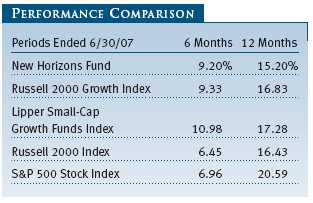
Although the fund’s 12-month returns lagged the indexes’ and its peer group’s performance, the comparisons of longer-term returns are much more favorable. The fund’s average annualized return for the three-year period was 12.96% compared with 11.48% for the Lipper Small-Cap Growth Index, the five-year period return was 15.29% compared with 11.98% for its Lipper peer group, and for the 10-year period, the return was 9.47% compared with 7.62% for the Lipper index. (Based on cumulative total return, Lipper ranked the New Horizons Fund 341 out of 565, 153 out of 458, 53 out of 380, and 69 out of 156 small-cap growth funds for the 1-, 3-, 5-, and 10-year periods ended June 30, 2007, respectively.) Past performance cannot guarantee future results. Long-term investors in the fund have been able to reap the benefits from the compounding effect of the fund’s better-than-peer performance.
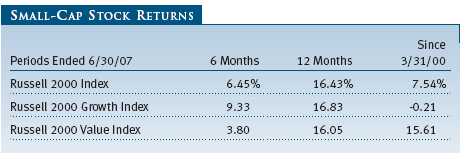
The Lipper organization returned the fund to the Small-Cap Growth category, meaning that we will no longer use the Lipper Mid-Cap Growth Funds Index as one of the fund’s benchmarks. As noted in our year-end report, we have not changed anything in our management style, but the fund has always owned a portfolio of stocks that straddle the breakpoint that Lipper has set between small- and mid-caps. At times, our low turnover, buy-and-hold strategy has moved the fund slightly into mid-cap territory, at least in Lipper’s eyes.
MARKET ENVIRONMENT
Overall U.S. economic growth remains healthy and, in fact, strengthened in the second quarter, overcoming the drag from the sharp downturn in the housing sector and from record-high gas prices. Weakness in the consumer sector has been more than offset by continued strength in the industrial/manufacturing sector, capital spending, and exports. Strong economic growth outside the U.S., particularly in emerging markets such as China and India, have had a positive spillover effect on our economy as well. Interest rates rose modestly in the U.S. and around the world in the first half but not enough to start choking off economic growth. The 10-year U.S. Treasury bond yield rose somewhat to just over 5%, but inflation remains contained except for the volatile food and energy areas. The Fed, although concerned with long-term inflation threats, kept the fed funds rate stable throughout the first half at 5.25%.
The strong economic backdrop has led to continued strength in corporate profits, albeit at a moderating pace. S&P 500 earnings have grown at a blistering double-digit rate for five consecutive years and are on a pace to grow at a high single-digit rate in 2007. Corporate profit margins remain near all-time highs, as global sources of supply keep labor and production costs well under control.
Most U.S. stock market indexes gained 5% to 10% in the first half in response to these favorable economic conditions. Investor sentiment remained strong throughout, quickly shrugging off several market scares, including a sharp drop off in the red-hot Chinese stock market in the first quarter, major problems in the subprime mortgage market in the second quarter, and a second-quarter backup in long-term interest rates.
A global financial system awash in liquidity also contributed meaningfully to the market’s strength this year as it has for the last several years. Fueled by strong returns in U.S. and global stock markets over the last five years and above-trend returns in many other asset classes, investors are chasing high returns around the world as never before. Risk premiums for higher-risk asset classes, such as small-cap stocks, emerging market securities, and higher-risk bonds, have been bid down to record low levels. U.S. and global private-equity funds have raised record sums of money seeking outsized returns. Banks and investment banks, also seeking above-average returns, are giving in to private-equity demands for record amounts of loans but with very few safeguards. Corporations, with balance sheets bulging with cash from recent years’ earnings, are joining the party too, making acquisitions at a near-record pace and repurchasing shares at record levels. The result of all this buyout activity: a net reduction in the overall supply of equities and more cash in the pockets of investors eager to reinvest their gains back into the equity markets. These trends seem likely to persist for at least a while longer, sending stock markets higher in the short run. But, unless fundamentals continue to strengthen to support the gains, this party will not end well for investors.
The recent proliferation of merger, acquisition, and private-equity buyout activity deserves further comment. Although the New Horizons Fund has benefited from the current wave of takeovers, with 17 buyouts in the first half of 2007 alone, the frenzy of leveraged buyouts (LBO) has presented us with some troubling situations. We believe that in a number of instances existing shareholders did not receive fair value for their shares, particularly where senior management teamed with private-equity firms in takeover offers. In these cases, we believe management has an inherent conflict of interest and may not seek the highest possible price for shareholders. In fact, acquisition premiums in management-led buyouts have been considerably lower than in strategic corporate takeovers when management is fighting for the highest possible price for itself and for all shareholders. It seems that boards of directors, which are supposed to protect and represent all the shareholders, find it very difficult to line up against management, their private-equity backers, and their legions of sophisticated investment bankers and lawyers.
As a result, we have taken a more activist role in several situations where we deemed the takeover offers involving portfolio companies were inadequate. In the case of longtime portfolio holding Laureate Education, which the CEO and a number of private-equity firms proposed to take over in late January at a modest premium that was well below our analysis of the company’s true value, we sent a letter to the company’s board of directors expressing our opposition to the transaction. We also submitted a filing with the SEC that allowed us to contact other shareholders to encourage them to oppose the transaction as well. Ultimately, the buyout price was boosted modestly, and, as of this date, the deal seems likely to go through, which, in our opinion, is still a disappointing outcome. With the increase in buyout activity generally, we intend to fight vigorously for you, our shareholders, and will oppose any transactions that we believe are not in your best interests. (Please refer to our portfolio of investments for the complete listing of holdings and the amount each represents in the portfolio.)
PORTFOLIO REVIEW
Takeovers and strong performance from our energy and telecommunication services holdings were the primary drivers in the six-month period. Financial stocks also posted solid gains. Weak returns from our consumer holdings, particularly homebuilders and restaurant companies, hurt our absolute and relative performance. Health care stocks, particularly biotechnology and pharmaceuticals, also detracted from the period’s returns.
The boom in corporate buyout activity had an impact on the fund’s six-month results. As mentioned earlier, 17 portfolio companies received takeover offers during the first half, nine from strategic corporate buyers and eight from private-equity firms. This compares to 18 companies acquired or taken private in all of 2006. Interestingly, in the strategic takeovers, the average acquisition premium was 27%, while in the private-equity-led transactions, the average premium was a considerably more modest 13%.
Three of the fund’s top-10 contributors were portfolio companies that received takeover proposals. AQuantive, a leader in the online advertising space, received a takeover offer from Microsoft at a whopping 85% premium to the stock’s price before the offer. Defense supplier Armor Holdings received an offer from BAE Systems at a 24% premium, and education provider Laureate Education was offered a much more modest 11% premium (subsequently raised slightly to 14%) from a CEO-led private-equity consortium. Other meaningful holdings receiving takeover offers included outpatient surgery firm United Surgical Partners, financial processor Investors Financial Services, energy services provider Hydril, and Internet software firm 24/7 Media. Companies in all sectors of the portfolio were subject to takeover proposals.
Our energy holdings were the fund’s standout performers in the first half, and our picks significantly outperformed the benchmark’s energy sector performance. Top-five holding FMC Technologies, a maker of subsea systems, fluid controls, and other products used principally in deep-water drilling, posted strong gains, benefiting from increased oil and gas exploration activity. Grant Prideco, a supplier of drill bits and pipes, also was a strong contributor. Other solid performers included the previously mentioned Hydril and National Oilwell Varco, which we sold somewhat prematurely during the period, as the stock continued to climb following our sales.
The continued boom in wireless telecommunications has been a favorite investment theme of ours for a number of years, and the fund has benefited from our significant overweighting in this sector as well as good stock selection. Once again, the fund’s largest holding, NII Holdings, which offers the Nextel push-to-talk technology in Mexico and other Latin American markets, was the top contributor. The stock rose 25% in the first half and is up 15-fold since we established our position in early 2003. NII is a great example of our investment approach of finding small companies with strong management and open-ended growth opportunities early in their life cycle and then holding onto these stocks for many years. NII Holdings remains one of the most vibrant, fastest-growing companies in the portfolio.
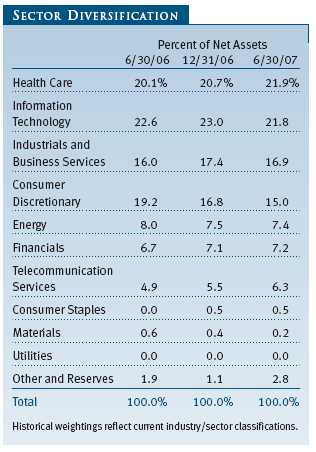
We also had good relative performance among our financial holdings. We have consistently avoided REITs and been underweighted in banks in recent years because we have been unable to find many companies with the consistent long-term earnings growth we seek. REITs and banks performed well in recent years (holding back our relative performance), but because of fears of an overheated real estate environment and concerns over the impact of the credit problems emanating from the subprime mortgage market’s meltdown, they underperformed this year. Asset management companies were solid performers, however. Long-time holding Affiliated Managers Group, an owner of several successful asset management firms, posted solid gains.
Consumer-related stocks were the fund’s worst performers. Our three homebuilding stocks, Toll Brothers, Ryland Group, and Meritage, declined sharply as the homebuilding downturn has been deeper and lasted longer than we anticipated. At this point, we believe investors have overreacted, with the stocks now selling close to book value. We still believe that homebuilding will be a growth sector in the years to come and that the publicly owned homebuilders are positioned to continue gaining market share in this fragmented industry.
A more challenging discretionary consumer spending environment resulted in weaker-than-expected sales that hurt a number of our holdings, including restaurant companies Panera Bread and P.F. Chang’s China Bistro and specialty retailers Finish Line and Hot Topic. With a healthy economy and strong overall employment, we believe consumer spending growth will recover and many of our holdings in this area will rebound from their current somewhat depressed levels.
Our health care holdings were lackluster performers, especially pharmaceutical and biotechnology stocks. We took advantage of this general weakness to add to the health care sector, where we believe secular earnings growth prospects remain strong, particularly as other parts of the economy slow. We initiated a position in Matria Healthcare and added to our holdings in Healthways, two leaders in the emerging disease-management field. All health care payors, commercial or government, are seeking ways to reduce and control the costs of chronic diseases and to promote wellness. Matria and Healthways are leaders in this area. Other new positions in the health care sector included Conceptus, a women’s health company; Nighthawk Radiology, a service provider for radiologists, and Allscripts Healthcare, a leading provider of health care technology software.
OUTLOOK
Our outlook for the economy and the stock market for the remainder of 2007 and into 2008 is positive. The domestic economy remains healthy, with solid growth continuing almost six years into the current cycle. Foreign economies are showing even stronger growth, especially developing countries like China and India, and this is helping many U.S. companies both in terms of lower production costs and stronger end-product demand. Weakness in the housing market and the broader consumer discretionary sector is being more than offset by strength in other parts of the economy. Inflation remains generally contained outside of food and energy, and interest rates are not high enough to restrain overall economic growth. Corporate earnings growth remains surprisingly strong for this stage in the economic cycle, with a high single-digit gain expected in 2007 and similar growth likely in 2008.
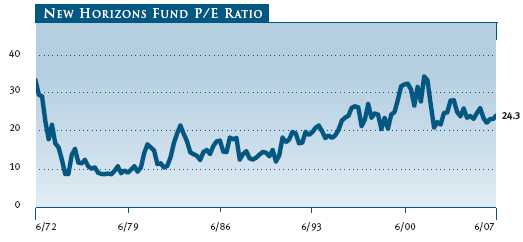
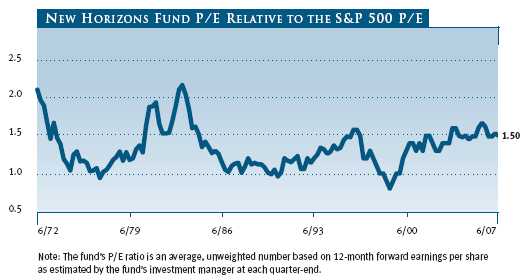
Unlike many past cyclical bull markets, valuations are not stretched. Due to the extraordinary strength in corporate earnings, price/earnings (P/E) ratios are lower today than at the start of this bull market in late 2002. Also, the quality of corporate earnings is extremely high, with exceedingly strong cash flow and a continued buildup of cash on corporate balance sheets. The international geopolitical situation remains worrisome due to unrest and terrorist activities spreading well beyond Iraq. Here at home, anti-Bush sentiment continues to rise and it appears likely that the next President will be a Democrat whose platform would probably favor higher income tax rates and less favorable treatment for dividends and capital gains. However, in the near term at least, a favorable economic backdrop combined with continued record levels of corporate and private-equity takeovers is likely to lead to further market gains.
Small-cap stocks have led the market for the past eight years but have performed in line with the large-cap sector in the first half of 2007. P/E ratios for small-caps are now modestly higher than large-caps, a situation that rarely persists. Large-cap earnings growth is more robust than small-cap earnings growth, as large-cap companies have greater overseas exposure, allowing them to benefit from both stronger growth outside the U.S. and from the dollar’s weakness. Absolute P/E levels for small-caps remain reasonable and in line with levels over the past decade. Valuations on other measures, such as price to book value and price to cash flow, are not particularly stretched. Relative to large-caps, however, small-cap P/Es remain very high. The New Horizons Fund relative P/E compared with the S&P 500 rose to 1.50x as of June 30, 2007, very close to its highest level in the past 25 years as shown on the accompanying chart.
Overall, we expect stock prices to continue to advance over the next six to 12 months and expect small-caps to benefit as well. A meaningful change in market leadership is unlikely as long as the market continues to climb. A continued record level of buyout activity will also favor small- and mid-cap companies over large-caps because most mega-cap companies are too large to take over. We are encouraged that small-cap growth stocks outperformed small-cap value in the first half and believe that the relative attractiveness of the small-cap growth sector to small-cap value has rarely been greater. T. Rowe Price’s research analysts continue to seek out and find many exciting small-cap companies with strong earnings growth potential. We believe the fund is well positioned to continue to deliver strong relative returns in the years to come.
Respectfully submitted,

John H. Laporte
President of the fund and chairman of its Investment Advisory Committee
July 25, 2007
The committee chairman has day-to-day responsibility for managing the portfolio and works with committee members in developing and executing the fund’s investment program.
RISKS OF STOCK INVESTING
As with all stock and bond mutual funds, each fund’s share price can fall because of weakness in the stock or bond markets, a particular industry, or specific holdings. Stock markets can decline for many reasons, including adverse political or economic developments, changes in investor psychology, or heavy institutional selling. The prospects for an industry or company may deteriorate because of a variety of factors, including disappointing earnings or changes in the competitive environment. In addition, the investment manager’s assessment of companies held in a fund may prove incorrect, resulting in losses or poor performance even in rising markets.
Investing in small companies involves greater risk than is customarily associated with larger companies. Stocks of small companies are subject to more abrupt or erratic price movements than larger-company stocks. Small companies often have limited product lines, markets, or financial resources, and their managements may lack depth and experience. Such companies seldom pay significant dividends that could cushion returns in a falling market.
GLOSSARY
Lipper indexes: Fund benchmarks that consist of a small number (10 to 30) of the largest mutual funds in a particular category as tracked by Lipper Inc.
Price/earnings ratio (P/E): A valuation measure calculated by dividing the price of a stock by its current or projected earnings per share. This ratio gives investors an idea of how much they are paying for current or future earnings power.
Russell 2000 Index: Consists of the smallest 2,000 companies in the Russell 3000 Index, representing approximately 7% of the Russell 3000’s total market capitalization. Performance is reported on a total return basis.
Russell 2000 Value Index: Market-weighted total return index that measures the performance of companies within the Russell 2000 Index having lower price/book value ratios and lower forecasted growth rates.
Russell 2000 Growth Index: Market-weighted total return index that measures the performance of companies within the Russell 2000 Index having higher price/book value ratios and higher forecasted growth rates.
S&P 500 Stock Index: An unmanaged index that tracks the stocks of 500 primarily large-cap U.S. companies.


Performance and Expenses
| GROWTH OF $10,000 |
This chart shows the value of a hypothetical $10,000 investment in the fund over the past 10 fiscal year periods or since inception (for funds lacking 10-year records). The result is compared with benchmarks, which may include a broad-based market index and a peer group average or index. Market indexes do not include expenses, which are deducted from fund returns as well as mutual fund averages and indexes.

| AVERAGE ANNUAL COMPOUND TOTAL RETURN |
This table shows how the fund would have performed each year if its actual (or cumulative) returns for the periods shown had been earned at a constant rate.


| FUND EXPENSE EXAMPLE |
As a mutual fund shareholder, you may incur two types of costs: (1) transaction costs, such as redemption fees or sales loads, and (2) ongoing costs, including management fees, distribution and service (12b-1) fees, and other fund expenses. The following example is intended to help you understand your ongoing costs (in dollars) of investing in the fund and to compare these costs with the ongoing costs of investing in other mutual funds. The example is based on an investment of $1,000 invested at the beginning of the most recent six-month period and held for the entire period.
Actual Expenses
The first line of the following table (“Actual”) provides information about actual account values and expenses based on the fund’s actual returns. You may use the information in this line, together with your account
balance, to estimate the expenses that you paid over the period. Simply divide your account value by $1,000 (for example, an $8,600 account value divided by $1,000 = 8.6), then multiply the result by the number in the first line under
the heading “Expenses Paid During Period” to estimate the expenses you paid on your account during this period.
Hypothetical Example for Comparison Purposes
The information on the second line of the table (“Hypothetical”) is based on hypothetical account values and expenses derived from the fund’s actual expense ratio and an assumed 5% per year rate of return before expenses
(not the fund’s actual return). You may compare the ongoing costs of investing in the fund with other funds by contrasting this 5% hypothetical example and the 5% hypothetical examples that appear in the shareholder reports of the other funds.
The hypothetical account values and expenses may not be used to estimate the actual ending account balance or expenses you paid for the period.
Note: T. Rowe Price charges an annual small-account maintenance fee of $10, generally for accounts with less than $2,000 ($500 for UGMA/UTMA). The fee is waived for any investor whose T. Rowe Price mutual fund accounts total $25,000 or more, accounts employing automatic investing, and IRAs and other retirement plan accounts that utilize a prototype plan sponsored by T. Rowe Price (although a separate custodial or administrative fee may apply to such accounts). This fee is not included in the accompanying table. If you are subject to the fee, keep it in mind when you are estimating the ongoing expenses of investing in the fund and when comparing the expenses of this fund with other funds.
You should also be aware that the expenses shown in the table highlight only your ongoing costs and do not reflect any transaction costs, such as redemption fees or sales loads. Therefore, the second line of the table is useful in
comparing ongoing costs only and will not help you determine the relative total costs of owning different funds. To the extent a fund charges transaction costs, however, the total cost of owning that fund is higher.
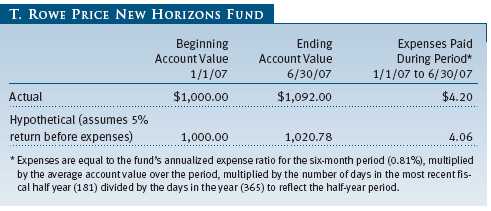
Unaudited
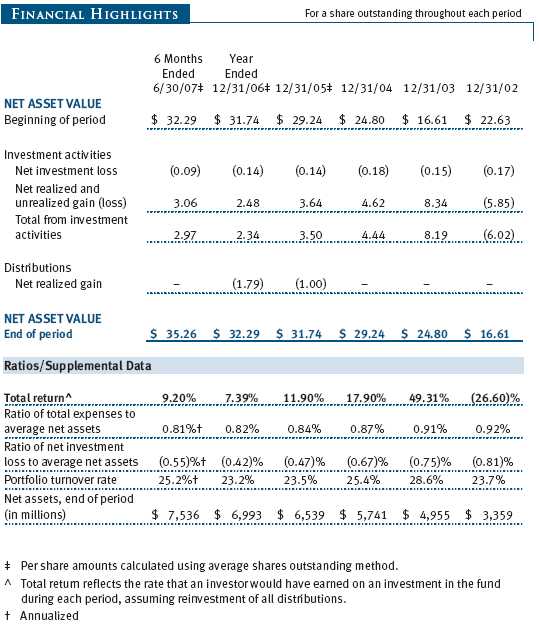
The accompanying notes are an integral part of these financial statements.
Unaudited
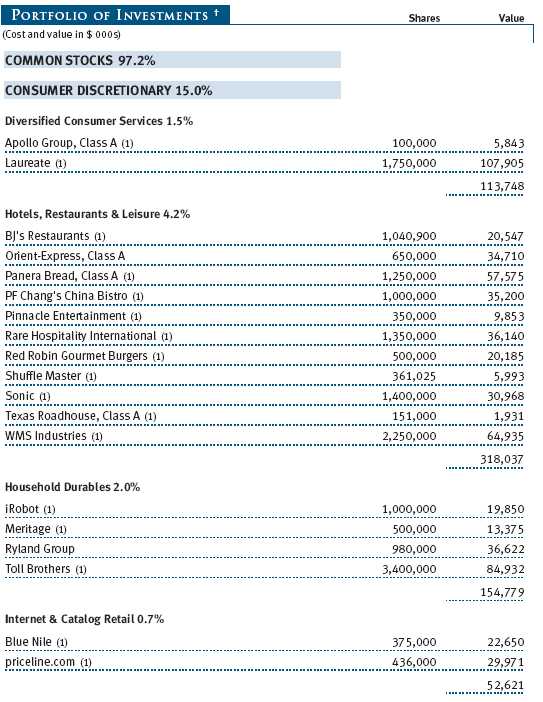
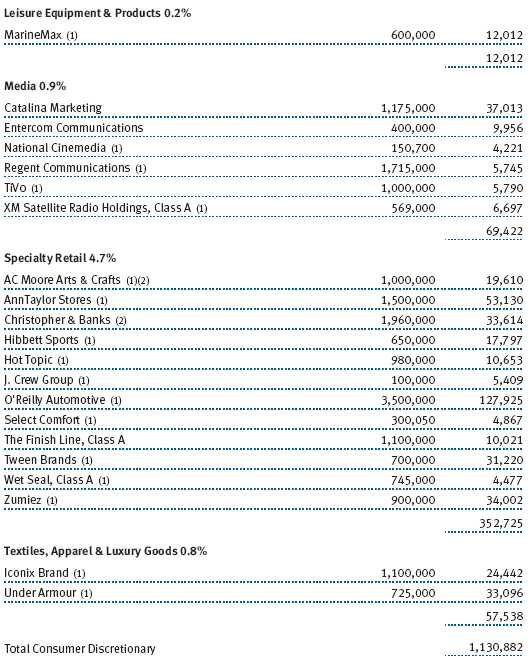
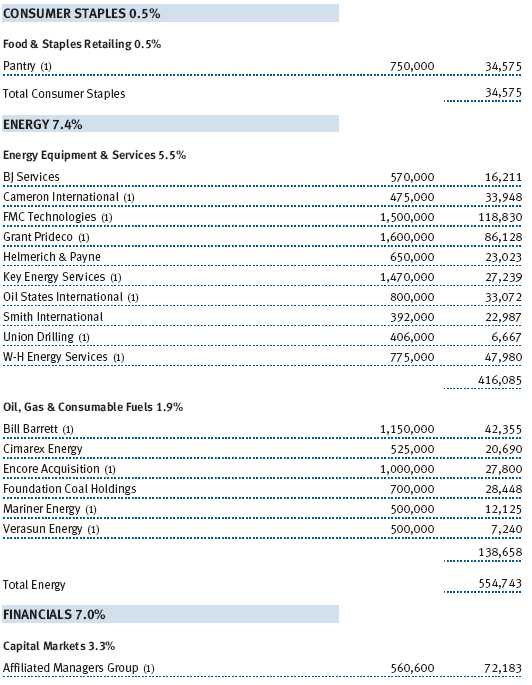

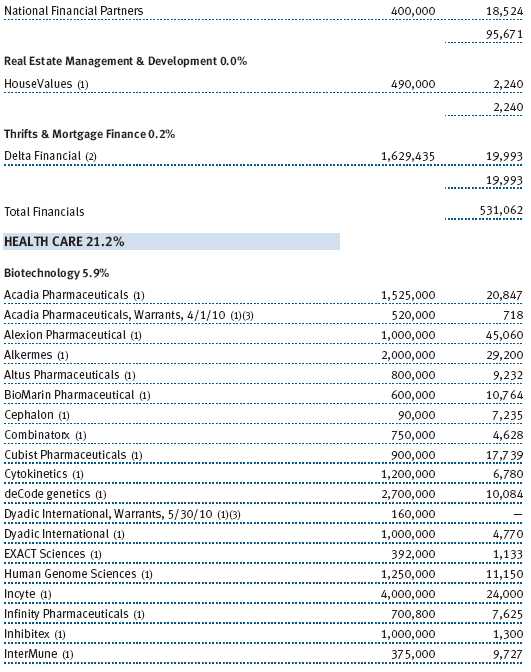
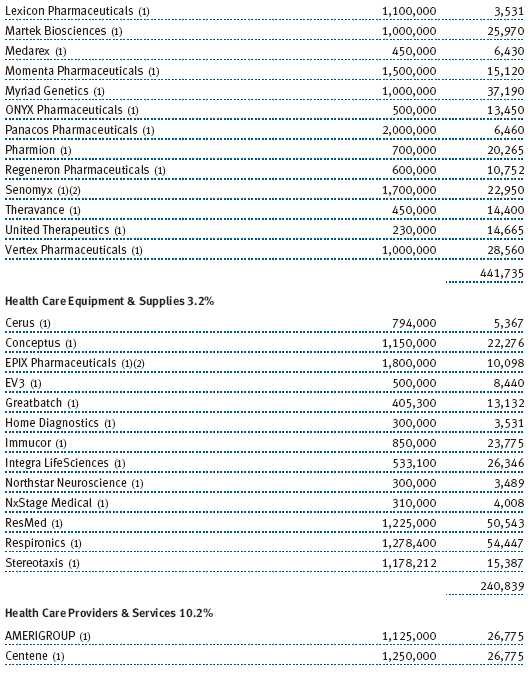
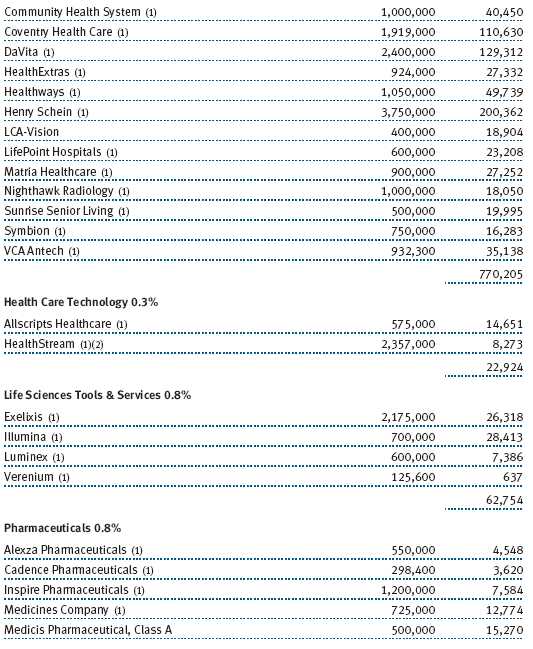
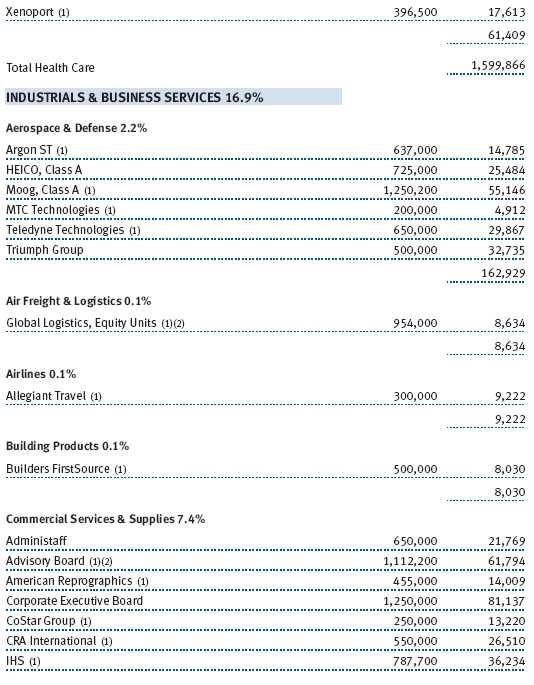
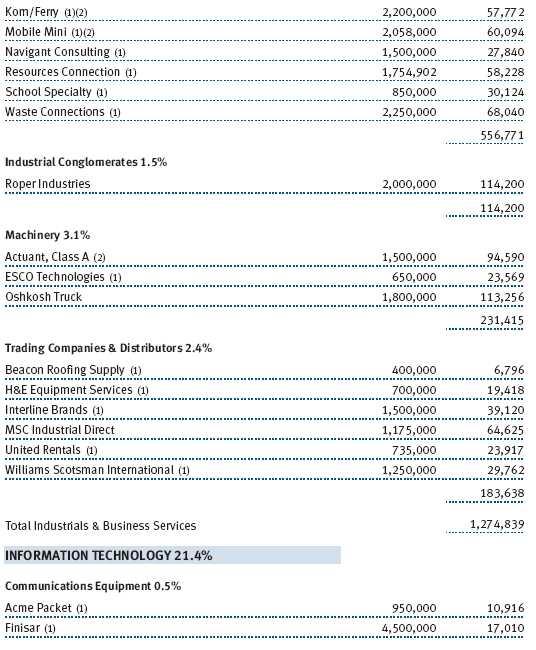

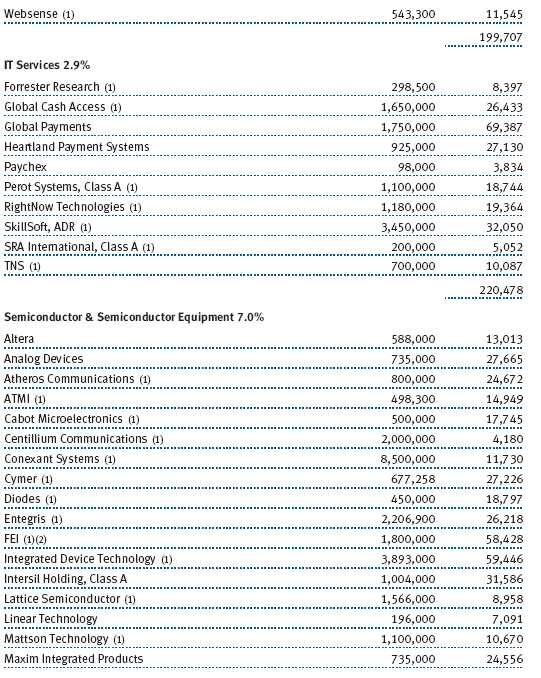
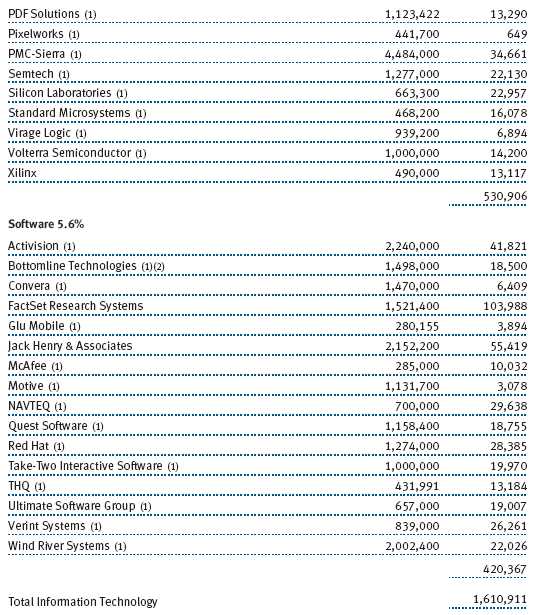
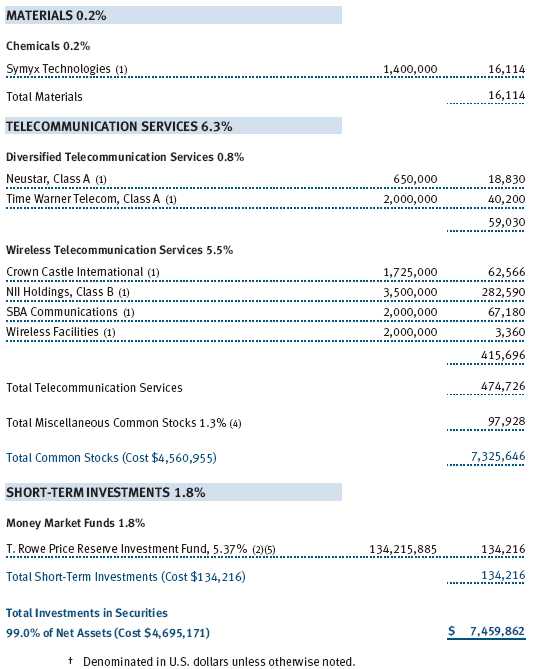

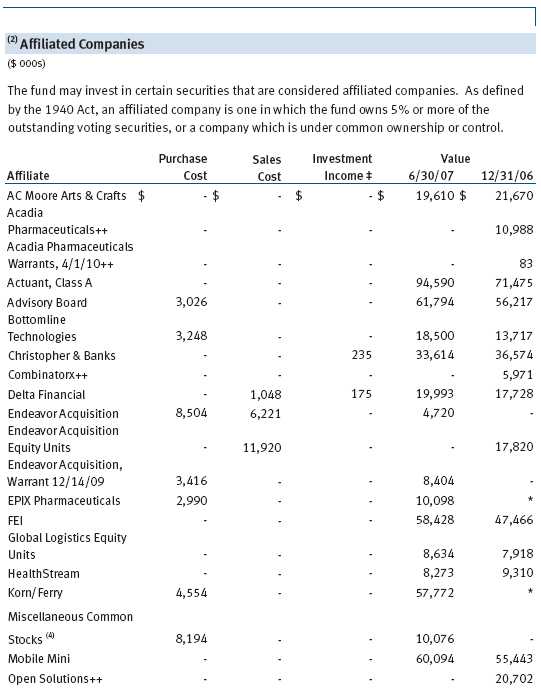
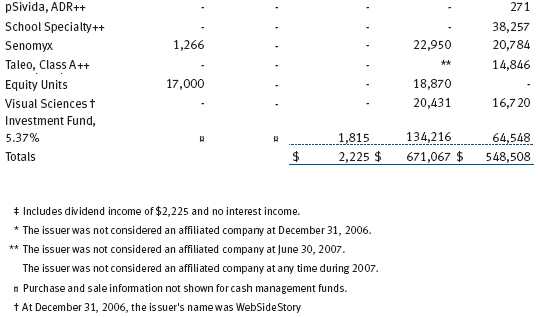
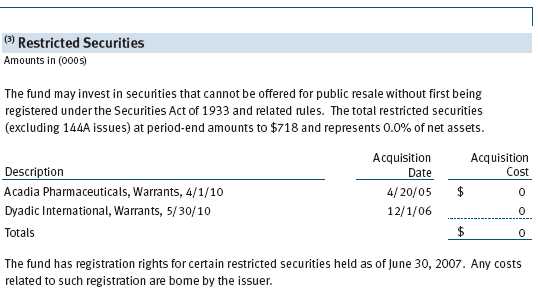
The accompanying notes are an integral part of these financial statements.
Unaudited
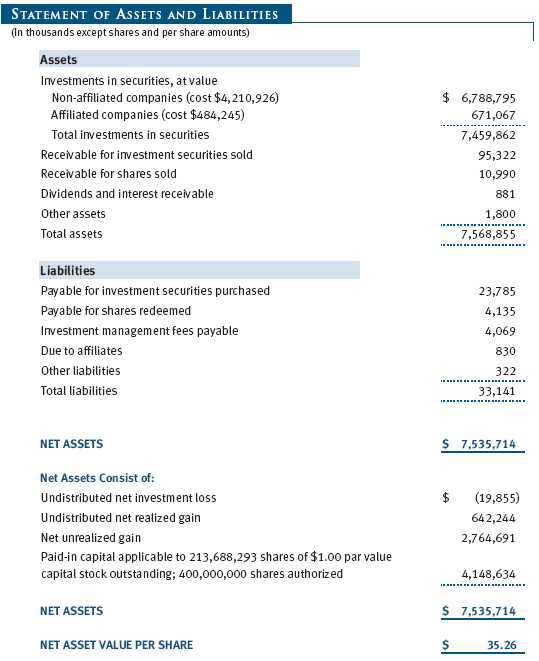
The accompanying notes are an integral part of these financial statements.
Unaudited
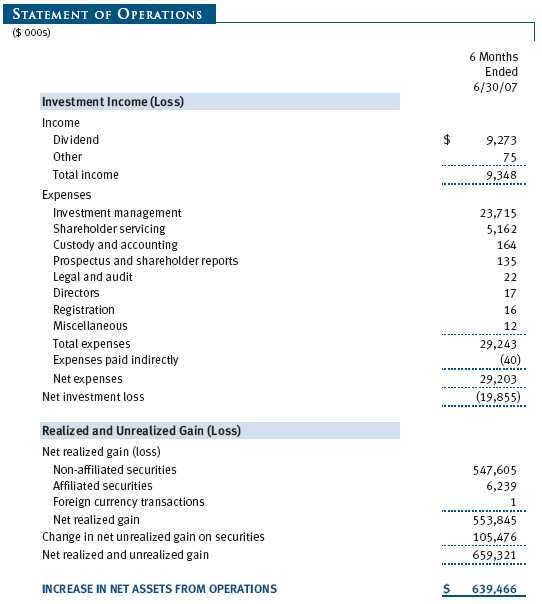
The accompanying notes are an integral part of these financial statements.
Unaudited
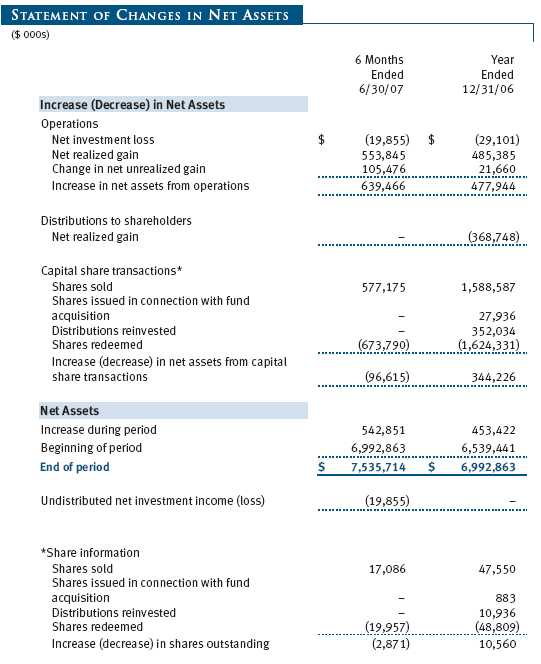
The accompanying notes are an integral part of these financial statements.
Unaudited
| NOTES TO FINANCIAL STATEMENTS |
NOTE 1 - SIGNIFICANT ACCOUNTING POLICIES
T. Rowe Price New Horizons Fund, Inc. (the fund), is registered under the Investment Company Act of 1940 (the 1940 Act) as a diversified, open-end management investment company. The fund commenced operations on June 3, 1960. The fund seeks long-term capital growth by investing primarily in common stocks of small, rapidly growing companies.
The accompanying financial statements were prepared in accordance with accounting principles generally accepted in the United States of America, which require the use of estimates made by fund management. Fund management believes that estimates and security valuations are appropriate; however, actual results may differ from those estimates, and the security valuations reflected in the financial statements may differ from the value the fund ultimately realizes upon sale of the securities.
Valuation The fund values its investments and computes its net asset value per share at the close of the New York Stock Exchange (NYSE), normally 4 p.m. ET, each day that the NYSE is open for business. Equity securities listed or regularly traded on a securities exchange or in the over-the-counter (OTC) market are valued at the last quoted sale price or, for certain markets, the official closing price at the time the valuations are made, except for OTC Bulletin Board securities, which are valued at the mean of the latest bid and asked prices. A security that is listed or traded on more than one exchange is valued at the quotation on the exchange determined to be the primary market for such security. Listed securities not traded on a particular day are valued at the mean of the latest bid and asked prices for domestic securities and the last quoted sale price for international securities.
Investments in mutual funds are valued at the mutual fund’s closing net asset value per share on the day of valuation.
Other investments, including restricted securities, and those for which the above valuation procedures are inappropriate or are deemed not to reflect fair value are stated at fair value as determined in good faith by the T. Rowe Price Valuation Committee, established by the fund’s Board of Directors.
Rebates and Credits Subject to best execution, the fund may direct certain security trades to brokers who have agreed to rebate a portion of the related brokerage commission to the fund in cash. Commission rebates are reflected as realized gain on securities in the accompanying financial statements and totaled $70,000 for the six months ended June 30, 2007. Additionally, the fund earns credits on temporarily uninvested cash balances at the custodian that reduce the fund’s custody charges. Custody expense in the accompanying financial statements is presented before reduction for credits, which are reflected as expenses paid indirectly.
Investment Transactions, Investment Income, and Distributions Income and expenses are recorded on the accrual basis. Dividends received from mutual fund investments are reflected as dividend income; capital gain distributions are reflected as realized gain/loss. Dividend income and capital gain distributions are recorded on the ex-dividend date. Any income tax-related interest and penalties would be classified as income tax expense. Investment transactions are accounted for on the trade date. Realized gains and losses are reported on the identified cost basis. Distributions to shareholders are recorded on the ex-dividend date. Income distributions are declared and paid on an annual basis. Capital gain distributions, if any, are declared and paid by the fund, typically on an annual basis.
New Accounting Pronouncements Effective June 29, 2007, the fund adopted Financial Accounting Standards Board (“FASB”) Interpretation No. 48 (“FIN 48”), Accounting for Uncertainty in Income Taxes, a clarification of FASB Statement No. 109, Accounting for Income Taxes. FIN 48 establishes financial accounting and disclosure requirements for recognition and measurement of tax positions taken or expected to be taken on an income tax return. The adoption of FIN 48 had no impact on the fund’s net assets or results of operations.
In September 2006, the FASB released the Statement of Financial Accounting Standard No. 157 (“FAS 157”), Fair Value Measurements. FAS 157 clarifies the definition of fair value and establishes the framework for measuring fair value, as well as proper disclosure of this methodology in the financial statements. It will be effective for the fund’s fiscal year beginning January 1, 2008. Management is evaluating the effects of FAS 157; however, it is not expected to have a material impact on the fund’s net assets or results of operations.
NOTE 2 - INVESTMENT TRANSACTIONS
Consistent with its investment objective, the fund engages in the following practices to manage exposure to certain risks or to enhance performance. The investment objective, policies, program, and risk factors of the fund are described more fully in the fund’s prospectus and Statement of Additional Information.
Restricted Securities The fund may invest in securities that are subject to legal or contractual restrictions on resale. Although certain of these securities may be readily sold, for example, under Rule 144A, others may be illiquid, their sale may involve substantial delays and additional costs, and prompt sale at an acceptable price may be difficult.
Other Purchases and sales of portfolio securities, other than short-term securities, aggregated $908,937,000 and $1,154,022,000, respectively, for the six months ended June 30, 2007.
NOTE 3 - FEDERAL INCOME TAXES
No provision for federal income taxes is required since the fund intends to continue to qualify as a regulated investment company under Subchapter M of the Internal Revenue Code and distribute to shareholders all of its taxable income and gains. Federal income tax regulations differ from generally accepted accounting principles; therefore, distributions determined in accordance with tax regulations may differ in amount or character from net investment income and realized gains for financial reporting purposes. Financial reporting records are adjusted for permanent book/tax differences to reflect tax character. Financial records are not adjusted for temporary differences. The amount and character of tax-basis distributions and composition of net assets are finalized at fiscal year-end; accordingly, tax-basis balances have not been determined as of June 30, 2007.
The fund intends to retain realized gains to the extent of available capital loss carryforwards. As of December 31, 2006, the fund had $4,875,000 of unused capital loss carryforwards, which expire in 2010. Further, $4,875,000 of the fund’s unused capital loss carryforwards may be subject to certain limitations on amount and/or timing of use related to being acquired through tax-free reorganizations.
At June 30, 2007, the cost of investments for federal income tax purposes was $4,695,171,000. Net unrealized gain aggregated $2,764,691,000 at period-end, of which $3,022,134,000 related to appreciated investments and $257,443,000 related to depreciated investments.
NOTE 4 - ACQUISITION
On June 19, 2006, the fund acquired substantially all of the assets of the Preferred Small-Cap Growth Fund (the acquired fund), pursuant to the Agreement and Plan of Reorganization dated February 15, 2006, and approved by shareholders of the acquired fund on June 9, 2006. The acquisition was accomplished by a tax-free exchange of 882,932 shares of the fund (with a value of $27,936,000) for all 2,907,270 shares of the acquired fund outstanding on June 16, 2006 with the same value. The net assets of the acquired fund at that date included $1,309,000 of unrealized depreciation and $5,526,000 of net realized losses carried forward for tax purposes to offset distributable gains realized by the fund in the future. Net assets of the acquired fund were combined with those of the fund, resulting in aggregate net assets of $6,611,967,000 immediately after the acquisition.
NOTE 5 - RELATED PARTY TRANSACTIONS
The fund is managed by T. Rowe Price Associates, Inc. (the manager or Price Associates), a wholly owned subsidiary of T. Rowe Price Group, Inc. The investment management agreement between the fund and the manager provides for an annual investment management fee, which is computed daily and paid monthly. The fee consists of an individual fund fee, equal to 0.35% of the fund’s average daily net assets, and a group fee. The group fee rate is calculated based on the combined net assets of certain mutual funds sponsored by Price Associates (the group) applied to a graduated fee schedule, with rates ranging from 0.48% for the first $1 billion of assets to 0.285% for assets in excess of $220 billion. The fund’s group fee is determined by applying the group fee rate to the fund’s average daily net assets. At June 30, 2007, the effective annual group fee rate was 0.30%.
In addition, the fund has entered into service agreements with Price Associates and two wholly owned subsidiaries of Price Associates (collectively, Price). Price Associates computes the daily share price and provides certain other administrative services to the fund. T. Rowe Price Services, Inc., provides shareholder and administrative services in its capacity as the fund’s transfer and dividend disbursing agent. T. Rowe Price Retirement Plan Services, Inc., provides subaccounting and recordkeeping services for certain retirement accounts invested in the fund. For the six months ended June 30, 2007, expenses incurred pursuant to these service agreements were $62,000 for Price Associates, $1,051,000 for T. Rowe Price Services, Inc., and $2,355,000 for T. Rowe Price Retirement Plan Services, Inc. The total amount payable at period-end pursuant to these service agreements is reflected as Due to Affiliates in the accompanying financial statements.
Additionally, the fund is one of several mutual funds in which certain college savings plans managed by Price Associates may invest. As approved by the fund’s Board of Directors, shareholder servicing costs associated with each college savings plan are borne by the fund in proportion to the average daily value of its shares owned by the college savings plan. For the six months ended June 30, 2007, the fund was charged $106,000 for shareholder servicing costs related to the college savings plans, of which $69,000 was for services provided by Price. The amount payable at period-end pursuant to this agreement is reflected as Due to Affiliates in the accompanying financial statements. At June 30, 2007, approximately 2% of the outstanding shares of the fund were held by college savings plans.
The fund is also one of several mutual funds sponsored by Price Associates (underlying Price funds) in which the T. Rowe Price Spectrum Funds (Spectrum Funds) and T. Rowe Price Retirement Funds (Retirement Funds) may invest. Neither the Spectrum Funds nor the Retirement Funds invest in the underlying Price funds for the purpose of exercising management or control. Pursuant to separate special servicing agreements, expenses associated with the operation of the Spectrum and Retirement Funds are borne by each underlying Price fund to the extent of estimated savings to it and in proportion to the average daily value of its shares owned by the Spectrum and Retirement Funds, respectively. Expenses allocated under these agreements are reflected as shareholder servicing expenses in the accompanying financial statements. For the six months ended June 30, 2007, the fund was allocated $324,000 of Spectrum Funds’ expenses and $459,000 of Retirement Funds’ expenses. Of these amounts, $542,000 related to services provided by Price. The amount payable at period-end pursuant to this agreement is reflected as Due to Affiliates in the accompanying financial statements. At June 30, 2007, approximately 6% of the outstanding shares of the fund were held by the Spectrum Funds and 6% were held by the Retirement Funds.
The fund may invest in the T. Rowe Price Reserve Investment Fund and the T. Rowe Price Government Reserve Investment Fund (collectively, the T. Rowe Price Reserve Investment Funds), open-end management investment companies managed by Price Associates and affiliates of the fund. The T. Rowe Price Reserve Investment Funds are offered as cash management options to mutual funds, trusts, and other accounts managed by Price Associates and/or its affiliates, and are not available for direct purchase by members of the public. The T. Rowe Price Reserve Investment Funds pay no investment management fees.
As of June 30, 2007, T. Rowe Price Group, Inc., and/or its wholly owned subsidiaries owned 139,524 shares of the fund, representing less than 1% of the fund’s net assets.
| INFORMATION ON PROXY VOTING POLICIES, PROCEDURES, AND RECORDS |
A description of the policies and procedures used by T. Rowe Price funds and portfolios to determine how to vote proxies relating to portfolio securities is available in each fund’s Statement of Additional Information, which you may request by calling 1-800-225-5132 or by accessing the SEC’s Web site, www.sec.gov. The description of our proxy voting policies and procedures is also available on our Web site, www.troweprice.com. To access it, click on the words “Company Info” at the top of our homepage for individual investors. Then, in the window that appears, click on the “Proxy Voting Policy” navigation button in the top left corner.
Each fund’s most recent annual proxy voting record is available on our Web site and through the SEC’s Web site. To access it through our Web site, follow the directions above, then click on the words “Proxy Voting Record” at the bottom of the Proxy Voting Policy page.
| HOW TO OBTAIN QUARTERLY PORTFOLIO HOLDINGS |
The fund files a complete schedule of portfolio holdings with the Securities and Exchange Commission for the first and third quarters of each fiscal year on Form N-Q. The fund’s Form N-Q is available electronically on the SEC’s Web site (www.sec.gov); hard copies may be reviewed and copied at the SEC’s Public Reference Room, 450 Fifth St. N.W., Washington, DC 20549. For more information on the Public Reference Room, call 1-800-SEC-0330.
| APPROVAL OF INVESTMENT MANAGEMENT AGREEMENT |
On March 7, 2007, the fund’s Board of Directors (Board) unanimously approved the investment advisory contract (Contract) between the fund and its investment manager, T. Rowe Price Associates, Inc. (Manager). The Board considered a variety of factors in connection with its review of the Contract, also taking into account information provided by the Manager during the course of the year, as discussed below:
Services Provided by the Manager
The Board considered the nature, quality, and extent of the services provided to the fund by the Manager. These services included, but were not limited to, management of the fund’s portfolio and a variety of related activities, as
well as financial and administrative services, reporting, and communications. The Board also reviewed the background and experience of the Manager’s senior management team and investment personnel involved in the management of the fund. The
Board concluded that it was satisfied with the nature, quality, and extent of the services provided by the Manager.
Investment Performance of the Fund
The Board reviewed the fund’s average annual total return over the 1-, 3-, 5-, and 10-year periods as well as the fund’s year-by-year returns and compared these returns with previously agreed upon comparable performance
measures and market data, including those supplied by Lipper and Morningstar, which are independent providers of mutual fund data. On the basis of this evaluation and the Board’s ongoing review of investment results, the Board concluded that
the fund’s performance was satisfactory.
Costs, Benefits, Profits, and Economies of Scale
The Board reviewed detailed information regarding the revenues received by the Manager under the Contract and other benefits that the Manager (and its affiliates) may have realized from its relationship with the fund, including research
received under “soft dollar” agreements. The Board noted that soft dollars were not used to pay for third-party, non-broker research. The Board also received information on the estimated costs incurred and profits realized by the Manager
and its affiliates from advising T. Rowe Price mutual funds, as well as estimates of the gross profits realized from managing the fund in particular. The Board concluded that the Manager’s profits were reasonable in light of the services
provided to the fund. The Board also considered whether the fund or other funds benefit under the fee levels set forth in the Contract from any economies of scale realized by the Manager. Under the Contract, the fund pays a fee to the Manager
composed of two components—a group fee rate based on the aggregate assets of certain T. Rowe Price mutual funds (including the fund) that declines at certain asset levels and an individual fund fee rate that is assessed on the assets of the
fund. The Board concluded that the advisory fee structure for the fund continued to provide for a reasonable sharing of benefits from any economies of scale with the fund’s investors.
Fees
The Board reviewed the fund’s management fee rate, operating expenses, and total expense ratio and compared them with fees and expenses of other comparable funds based on information and data supplied by Lipper. The information
provided to the Board indicated that the fund’s management fee rate was above the median for certain groups of comparable funds but at or below the median for other groups of comparable funds. The information also indicated that the fund’s
expense ratio was below the median for comparable funds. The Board also reviewed the fee schedules for comparable privately managed accounts of the Manager and its affiliates. Management informed the Board that the Manager’s responsibilities
for privately managed accounts are more limited than its responsibilities for the fund and other T. Rowe Price mutual funds that it or its affiliates advise. On the basis of the information provided, the Board concluded that the fees paid by the
fund under the Contract were reasonable.
Approval of the Contract
As noted, the Board approved the continuation of the Contract. No single factor was considered in isolation or to be determinative to the decision. Rather, the Board concluded, in light of a weighting and balancing of all factors
considered, that it was in the best interests of the fund to approve the continuation of the Contract, including the fees to be charged for services thereunder.
Item 2. Code of Ethics.
A code of ethics, as defined in Item 2 of Form N-CSR, applicable to its principal executive officer, principal financial officer, principal accounting officer or controller, or persons performing similar functions is filed as an exhibit to the registrant’s annual Form N-CSR. No substantive amendments were approved or waivers were granted to this code of ethics during the registrant’s most recent fiscal half-year.
Item 3. Audit Committee Financial Expert.
Disclosure required in registrant’s annual Form N-CSR.
Item 4. Principal Accountant Fees and Services.
Disclosure required in registrant’s annual Form N-CSR.
Item 5. Audit Committee of Listed Registrants.
Not applicable.
Item 6. Schedule of Investments.
Not applicable. The complete schedule of investments is included in Item 1 of this Form N-CSR.
Item 7. Disclosure of Proxy Voting Policies and Procedures for Closed-End Management Investment Companies.
Not applicable.
Item 8. Portfolio Managers of Closed-End Management Investment Companies.
Not applicable.
Item 9. Purchases of Equity Securities by Closed-End Management Investment Company and Affiliated Purchasers.
Not applicable.
Item 10. Submission of Matters to a Vote of Security Holders.
Not applicable.
Item 11. Controls and Procedures.
(a) The registrant’s principal executive officer and principal financial officer have evaluated the registrant’s disclosure controls and procedures within 90 days of this filing and have concluded that the registrant’s disclosure controls and procedures were effective, as of that date, in ensuring that information required to be disclosed by the registrant in this Form N-CSR was recorded, processed, summarized, and reported timely.
(b) The registrant’s principal executive officer and principal financial officer are aware of no change in the registrant’s internal control over financial reporting that occurred during the registrant’s second fiscal quarter covered by this report that has materially affected, or is reasonably likely to materially affect, the registrant’s internal control over financial reporting.
Item 12. Exhibits.(a)(1) The registrant’s code of ethics pursuant to Item 2 of Form N-CSR is filed with the registrant’s annual Form N-CSR.
(2) Separate certifications by the registrant's principal executive officer and principal financial officer, pursuant to Section 302 of the Sarbanes-Oxley Act of 2002 and required by Rule 30a-2(a) under the Investment Company Act of 1940, are attached.
(3) Written solicitation to repurchase securities issued by closed-end companies: not applicable.
(b) A certification by the registrant's principal executive officer and principal financial officer, pursuant to Section 906 of the Sarbanes-Oxley Act of 2002 and required by Rule 30a-2(b) under the Investment Company Act of 1940, is attached.
|
SIGNATURES
|
|
| Pursuant to the requirements of the Securities Exchange Act of 1934 and the Investment | |
| Company Act of 1940, the registrant has duly caused this report to be signed on its behalf by the | |
| undersigned, thereunto duly authorized. | |
| T. Rowe Price New Horizons Fund, Inc. | |
| By | /s/ Edward C. Bernard |
| Edward C. Bernard | |
| Principal Executive Officer | |
| Date | August 17, 2007 |
| Pursuant to the requirements of the Securities Exchange Act of 1934 and the Investment | |
| Company Act of 1940, this report has been signed below by the following persons on behalf of | |
| the registrant and in the capacities and on the dates indicated. | |
| By | /s/ Edward C. Bernard |
| Edward C. Bernard | |
| Principal Executive Officer | |
| Date | August 17, 2007 |
| By | /s/ Joseph A. Carrier |
| Joseph A. Carrier | |
| Principal Financial Officer | |
| Date | August 17, 2007 |